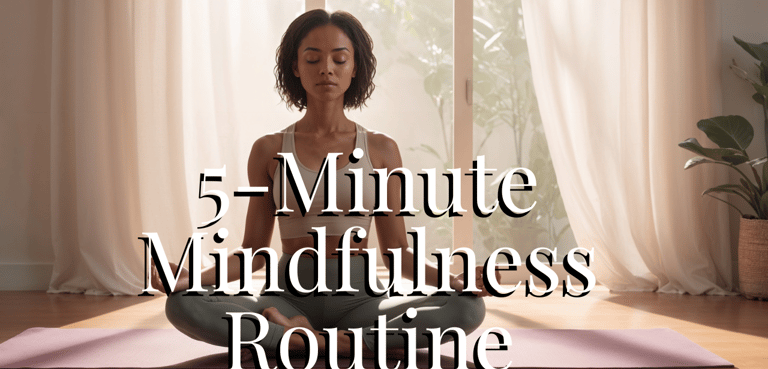5-Minute Daily Mindfulness Routine: A Fast Track to Calm, Clarity & Inner Balance
Feeling overwhelmed? This 5-minute daily mindfulness routine will help you slow down, breathe, and reconnect. Perfect for beginners and busy women. Add this to your morning for mental clarity, emotional balance, and inner peace.
Holistic Healthvibe
7/10/20253 min read


Why a 5-Minute Practice Changes Everything
If you’ve ever said, “I don’t have time to meditate,” this post is for you. Mindfulness isn’t about disappearing to a mountaintop for hours; it’s about learning to meet yourself—right here, right now—no matter how busy life feels. Just 10 intentional minutes can lower cortisol, improve focus, and increase emotional resilience.¹ Think of it as a mini-vacation for your nervous system—one that fits between the morning alarm and the first sip of coffee.
The 10-Step Mindfulness Flow
Below you’ll find the exact routine featured in our video. Feel free to bookmark or print these steps so they’re always within reach.
The Science Behind “Short & Sweet”
Cognitive Benefits: Research shows that as little as 8–12 minutes of mindful breathing a day improves working memory and decision-making speed.²
Emotional Regulation: Brief daily practices thicken the prefrontal cortex—your brain’s “CEO”—enhancing emotional self-control.³
Physical Health: Consistent mindfulness lowers systolic blood pressure and may reduce inflammatory markers like CRP.⁴
Translation? Ten minutes isn’t a compromise; it’s clinically meaningful.
Making It Stick: Tips for Busy Humans
Pair It With a Habit You Already Have
Do your routine right after brushing your teeth or before opening your laptop. The brain loves piggy-backing.Use Environmental Cues
Keep a dedicated cushion, candle, or even a small plant in your mindful corner. Seeing it = instant reminder.Start With a Two-Minute “Teaser”
If 10 minutes feels daunting, begin with two. Add one extra minute each week. Progress, not perfection.Track Your Streak
Apps, habit journals, or even a sticky-note calendar can provide a dopamine hit every time you check a box.Celebrate Micro-Wins
Did you show up today? That’s a win—regardless of how distracted you felt. Cue internal or external high-five.
Frequently Asked Questions
“I can’t sit still. Is something wrong with me?”
Absolutely not. Restlessness is common—especially at first. Try mindful walking or gentle stretches; the key is awareness, not immobility.
“What if I fall asleep?”
It happens! If you’re dozing off, practice sitting upright instead of reclining, or schedule your session earlier in the day.
“Can children do this routine?”
Yes! Shorten each step to 30-45 seconds and use imaginative cues like “pretend you’re blowing up a balloon” for breathing. Family mindfulness is a powerful bonding tool.
Integrate, Don’t Isolate
Mindfulness shines when it permeates the everyday. After a few weeks, notice how the practice spills into random moments: the pause before replying to an email, the choice to savor lunch instead of scrolling, the newfound patience in traffic. That’s when you know the routine has transitioned from task to tool.
Your Next Step
Ready to anchor calm into your mornings?
Download the Free Printable Checklist—perfect for your fridge or planner.
Share Your Experience in the comments: Which step feels the easiest? Which do you struggle with? We’re a community, and your journey inspires others.
Step
1. Find Your Space
2. Breathe Deeply
3. Scan Your Body
4. Observe Your Breath
5. Acknowledge Thoughts
6. Relax Tension
7. Feel Grounded
8. Express Gratitude
9. Set an Intention
10. Return Slowly
What to Do
Sit or stand somewhere you feel safe and undisturbed. Silence notifications.
Inhale through the nose for 4, exhale through the mouth for 6. Repeat 3×
Mentally move from crown to toes, relaxing each area.
Let breathing return to its natural rhythm. Simply watch it
When distractions pop up, say, “Thinking,” then refocus on breath.
On each exhale, drop your shoulders, unclench jaw, soften belly.
Notice the chair, floor, or earth supporting you.
Whisper one thing you’re grateful for right now.
“Today, I choose to be present (or calm, loving, focused).”
Wiggle fingers and toes, open eyes, take one final deep breath.
Why It Matters
Signals your brain that it’s time to switch from “doing” to “being.”
Activates the vagus nerve, nudging your body into rest-and-digest mode
Promotes mind-body connection and releases hidden tension.
Teaches non-reactive awareness—the heart of mindfulness.
Builds concentration while reducing mental clutter.
Encourages parasympathetic dominance, easing stress hormones.
Creates a sense of stability—even on chaotic days.
Shifts neural pathways toward positivity and dopamine release.
Gives the mind a single, empowering directive for the day.
Transitions you back to activity without the jarring rush.
Address
Baltimore, MD
Quick Links


©2025.Holistic Health vibe. All Rights Reserved.
